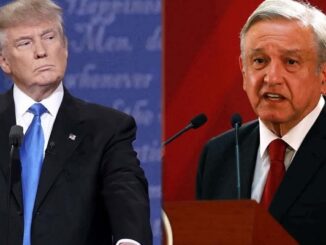
by Matthew Rooney
Strengthening the North American economic relationship rather than pulling back from it would better support stronger economic growth and secure American jobs.
This essay is part of a new series of policy recommendations from the George W. Bush Institute. To read more, visit What’s Next: Policy Recommendations from the Bush Institute. Download this essay as a PDF
The United States has the great advantage of being part of the most economically competitive region in the world — North America. Despite this, the U.S. recovery from the Great Recession has been inadequately slow, causing sustained economic anxiety among the middle class. Strengthening the North American economic relationship rather than pulling back from it would better support stronger economic growth and secure American jobs.
Like any agreement that results from a negotiation, the North American Free Trade Agreement is not perfect. All three parties made concessions in making the deal, and implementation has had varied effects in all three countries. Anyone who believes that NAFTA has been on balance positive for all three countries should put forward ideas for addressing any downsides.
In fact, the George W. Bush Institute’s North America Competitiveness Initiative has done just this. We brought together a group of senior experts from the worlds of business, academia, and public policy over the past year to develop a set of proposals for enhancing our prosperity.
We started with a benchmark of North America’s global competitiveness against other trading nations, and analyzed the growing trade and investment relationships among the North American nations. The results, available on our website, propose a number of concrete ways that government and industry could work together to ensure that the opportunities created by NAFTA are more widely beneficial.
Our analysis suggests that NAFTA is unfairly blamed for the loss of employment in our manufacturing sector over the past several decades. It is true that manufacturing employment in the U.S. has declined from 25% of total employment in 1960 to less than 10% today, but the decline began long before NAFTA was signed.
During this period, manufacturing output as a share of GDP has held steady at about 12%. Given that U.S. GDP grew from just over $500 billion in 1960 to $17.9 trillion in 2015, U.S. manufacturing output has actually increased during this period, from about $60 billion to $2.1 trillion – an increase of 3,400%.
At the same time, with population growth, total employment in the U.S. has grown from almost 54 million in 1960 to just over 143 million in 2015. So, even as employment in manufacturing has declined as a share of total employment, the number of jobs in manufacturing has actually held steady at about 13 million.
In short, the decline in manufacturing employment seems more to do with innovation and productivity increases, and with the expansion of the services sector of the economy, than with trade.
These facts are important for a number of reasons.
- They suggest that the U.S. is not “deindustrializing,” no matter how many times your friends joke about it.
- They point to a truly remarkable development: manufacturing output per worker went from $4,400 in 1960 to over $155,000 per worker in 2015. These are current dollars, but even adjusted for inflation this degree of productivity-driven prosperity growth is unusual in human history; we should be proud of it and look for ways to make sure it continues.
- When taken together with the analysis presented in the web tool mentioned above, they suggest that the downsides to the globalization of our economy are not the fault of inadequate trade policy.Rather, they should be blamed on poor domestic policies: education and training that don’t equip people for the job market and then enable them to keep pace as those jobs evolve; failure to invest in infrastructure; regulations that raise costs without producing commensurate benefits; and labor policies that don’t effectively promote retraining and job transition.
- Most importantly, they point the way to a truly effective policy approach to securing our nation’s prosperity by promoting American manufacturing. A policy like this would have five elements that the incoming administration could do in concert with our North American partners to promote a strong domestic economy:
Reform the U.S. Presidential Permit process to empower entrepreneurs and reduce uncertainty
Currently, building a road or pipeline across our borders requires a political determination by the State Department that the project is in the national interest. The resulting scrum of lobbyists and consultants tends to favor the best-connected and best-funded, not necessarily the project that would best increase productivity and competitiveness.
A reform would reduce the cost of developing infrastructure like roads, rail lines, bridges, and pipelines that cross the borders of North America. The reform also would make U.S. manufactured goods more globally competitive and secure manufacturing jobs.
Promote a regional approach to workforce development standards and certification
Varying standards raise the cost of recruiting and training, depressing productivity and incomes. Higher standards developed with private sector leadership will boost productivity of labor, similarly making our manufactured goods more competitive and securing manufacturing and logistics jobs.
Encourage private capital to invest in infrastructure across borders
This kind of investment will empower the market to drive priorities and strengthen the competitiveness of our supply chains. The result will be a reduction in unnecessary delays, again making our manufactured goods more competitive and securing manufacturing and logistics jobs. As we talk about a major investment in general infrastructure, it is important to ensure that cross-border infrastructure is able to support our global competitiveness.
Strengthen cooperation on regulations
We need better cooperation on regulations of products from cars to jellybeans to eliminate and prevent the emergence of standards that differ without enhancing health or safety.
These strategies will reduce production costs, further strengthening competitiveness of our products and securing manufacturing jobs.
Ensure consistency of safety standards in the exploration, production, refining, and distribution of energy
Common standards will reduce the cost of energy, further strengthening our manufacturing competitiveness and securing manufacturing and logistics jobs.
These policies would strengthen our manufacturing base while preserving the competitive advantages of trade with our Canadian and Mexican neighbors. They could also open new job opportunities as they boost production and productivity.
To really address the anxiety about our economic future, efforts like these should be coupled with education, training and labor market policies that promote innovation and growth in emerging industries.
The outcome of our recent election underscores how high the stakes are in this debate. The incoming administration would be well advised to ensure a high-level focus on addressing them from the outset.
An advisor within the senior staff of the National Security Council empowered to ensure that the bureaucracy thinks outside the box to develop an effective strategy would be a good start. A credible commitment to a structured North American Leaders’ Summit with accountability and follow-up would ensure that the Canadian and Mexican governments see the imperative for their own prosperity of working constructively with us.
NAFTA hasn’t been as harmful to the U.S. economy as its critics claim, but its defenders are wrong to resist efforts to review and update it. With appropriate political and bureaucratic focus, and with robust supporting policies, it can and should be a tool for securing the prosperity of the U.S. – and Canada and Mexico – for the coming decades. That would be a winning strategy.
Matt Rooney is the Director of Economic Growth at the Bush Center. joined the Bush Center in June 2015 from a career as a Foreign Service Officer with the U.S. Department of State.
This essay is part of a new series of policy recommendations from the George W. Bush Institute. To read more, visit What’s Next: Policy Recommendations from the Bush Institute. Download this essay as a PDF
The United States has the great advantage of being part of the most economically competitive region in the world — North America. Despite this, the U.S. recovery from the Great Recession has been inadequately slow, causing sustained economic anxiety among the middle class. Strengthening the North American economic relationship rather than pulling back from it would better support stronger economic growth and secure American jobs.
Like any agreement that results from a negotiation, the North American Free Trade Agreement is not perfect. All three parties made concessions in making the deal, and implementation has had varied effects in all three countries. Anyone who believes that NAFTA has been on balance positive for all three countries should put forward ideas for addressing any downsides.
In fact, the George W. Bush Institute’s North America Competitiveness Initiative has done just this. We brought together a group of senior experts from the worlds of business, academia, and public policy over the past year to develop a set of proposals for enhancing our prosperity.
We started with a benchmark of North America’s global competitiveness against other trading nations, and analyzed the growing trade and investment relationships among the North American nations. The results, available on our website, propose a number of concrete ways that government and industry could work together to ensure that the opportunities created by NAFTA are more widely beneficial.
Our analysis suggests that NAFTA is unfairly blamed for the loss of employment in our manufacturing sector over the past several decades. It is true that manufacturing employment in the U.S. has declined from 25% of total employment in 1960 to less than 10% today, but the decline began long before NAFTA was signed.
During this period, manufacturing output as a share of GDP has held steady at about 12%. Given that U.S. GDP grew from just over $500 billion in 1960 to $17.9 trillion in 2015, U.S. manufacturing output has actually increased during this period, from about $60 billion to $2.1 trillion – an increase of 3,400%.
At the same time, with population growth, total employment in the U.S. has grown from almost 54 million in 1960 to just over 143 million in 2015. So, even as employment in manufacturing has declined as a share of total employment, the number of jobs in manufacturing has actually held steady at about 13 million.
In short, the decline in manufacturing employment seems more to do with innovation and productivity increases, and with the expansion of the services sector of the economy, than with trade.
These facts are important for a number of reasons.
- They suggest that the U.S. is not “deindustrializing,” no matter how many times your friends joke about it.
- They point to a truly remarkable development: manufacturing output per worker went from $4,400 in 1960 to over $155,000 per worker in 2015. These are current dollars, but even adjusted for inflation this degree of productivity-driven prosperity growth is unusual in human history; we should be proud of it and look for ways to make sure it continues.
- When taken together with the analysis presented in the web tool mentioned above, they suggest that the downsides to the globalization of our economy are not the fault of inadequate trade policy.Rather, they should be blamed on poor domestic policies: education and training that don’t equip people for the job market and then enable them to keep pace as those jobs evolve; failure to invest in infrastructure; regulations that raise costs without producing commensurate benefits; and labor policies that don’t effectively promote retraining and job transition.
- Most importantly, they point the way to a truly effective policy approach to securing our nation’s prosperity by promoting American manufacturing. A policy like this would have five elements that the incoming administration could do in concert with our North American partners to promote a strong domestic economy:
Reform the U.S. Presidential Permit process to empower entrepreneurs and reduce uncertainty
Currently, building a road or pipeline across our borders requires a political determination by the State Department that the project is in the national interest. The resulting scrum of lobbyists and consultants tends to favor the best-connected and best-funded, not necessarily the project that would best increase productivity and competitiveness.
A reform would reduce the cost of developing infrastructure like roads, rail lines, bridges, and pipelines that cross the borders of North America. The reform also would make U.S. manufactured goods more globally competitive and secure manufacturing jobs.
Promote a regional approach to workforce development standards and certification
Varying standards raise the cost of recruiting and training, depressing productivity and incomes. Higher standards developed with private sector leadership will boost productivity of labor, similarly making our manufactured goods more competitive and securing manufacturing and logistics jobs.
Encourage private capital to invest in infrastructure across borders
This kind of investment will empower the market to drive priorities and strengthen the competitiveness of our supply chains. The result will be a reduction in unnecessary delays, again making our manufactured goods more competitive and securing manufacturing and logistics jobs. As we talk about a major investment in general infrastructure, it is important to ensure that cross-border infrastructure is able to support our global competitiveness.
Strengthen cooperation on regulations
We need better cooperation on regulations of products from cars to jellybeans to eliminate and prevent the emergence of standards that differ without enhancing health or safety.
These strategies will reduce production costs, further strengthening competitiveness of our products and securing manufacturing jobs.
Ensure consistency of safety standards in the exploration, production, refining, and distribution of energy
Common standards will reduce the cost of energy, further strengthening our manufacturing competitiveness and securing manufacturing and logistics jobs.
These policies would strengthen our manufacturing base while preserving the competitive advantages of trade with our Canadian and Mexican neighbors. They could also open new job opportunities as they boost production and productivity.
To really address the anxiety about our economic future, efforts like these should be coupled with education, training and labor market policies that promote innovation and growth in emerging industries.
The outcome of our recent election underscores how high the stakes are in this debate. The incoming administration would be well advised to ensure a high-level focus on addressing them from the outset.
An advisor within the senior staff of the National Security Council empowered to ensure that the bureaucracy thinks outside the box to develop an effective strategy would be a good start. A credible commitment to a structured North American Leaders’ Summit with accountability and follow-up would ensure that the Canadian and Mexican governments see the imperative for their own prosperity of working constructively with us.
NAFTA hasn’t been as harmful to the U.S. economy as its critics claim, but its defenders are wrong to resist efforts to review and update it. With appropriate political and bureaucratic focus, and with robust supporting policies, it can and should be a tool for securing the prosperity of the U.S. – and Canada and Mexico – for the coming decades. That would be a winning strategy.
Matt Rooney is the Director of Economic Growth at the Bush Center. joined the Bush Center in June 2015 from a career as a Foreign Service Officer with the U.S. Department of State.



